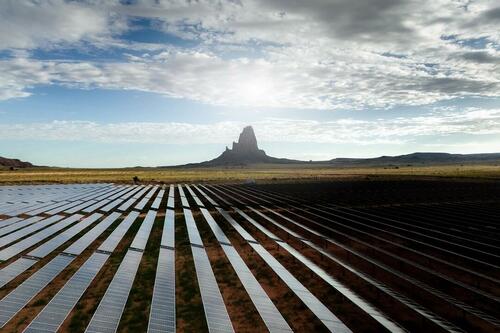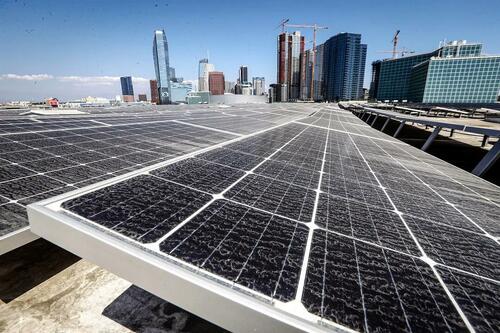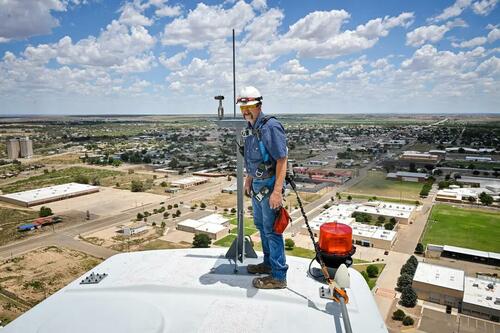
Focus On Renewable Energy Spurs Concerns Over Supply–Demand Equation
Authored by John Haughey via The Epoch Times (emphasis ours),
The nation’s utilities generated 5 percent more electricity during the first six months of 2024 than the first half of 2023 because of a hotter-than-normal start to summer and increasing power demands from the commercial sector, the Energy Information Administration (EIA) reported in its July Short-Term Energy Outlook.
 The Kayenta Solar Plant in Kayenta, Ariz., on June 23, 2024. In late February, the U.S. Department of Energy announced that it would begin plans to provide $76.5 million in federal financing to the Navajo Nation’s Red Mesa Tapaha Solar Farm in southeast Utah. (Brandon Bell/Getty Images)
The Kayenta Solar Plant in Kayenta, Ariz., on June 23, 2024. In late February, the U.S. Department of Energy announced that it would begin plans to provide $76.5 million in federal financing to the Navajo Nation’s Red Mesa Tapaha Solar Farm in southeast Utah. (Brandon Bell/Getty Images)Some fear intermittent renewable energy from the sun, the wind, water pressure, or geothermal steam cannot reliably keep pace with rapidly growing energy demands without redundant fossil fuel generation unless, or until, battery storage and transmission technologies advance.
Renewable energy sources—solar, wind, geothermal, biomass, hydro—constitute nearly 95 percent of that added capacity and now generate more than 21 percent of the nation’s electricity, eclipsing coal as a source last year, the EIA said.
The EIA projects that global electricity demand could increase between 30 percent to more than 75 percent of current capacity by 2050, with as much as two-thirds of electricity to come from nuclear and renewables.
The agency projects U.S. power plants will produce 2 percent more electricity during the second half of 2024 than in 2023, with solar power adding 36 billion kilowatt-hours, a 42-percent increase over the new solar power added in all of 2023.
With the additions, the sun now generates nearly 4 percent of utility-scale electricity and powers 7 percent of the nation’s homes, the EIA said, citing solar energy as the nation’s “fastest-growing U.S. source” for electricity generation.
The Washington-based Solar Energy Industries Association (SEIA), which did not return requests for comment from The Epoch Times, maintains that renewable energies are poised to dramatically accelerate, especially solar power.
SEIA in May announced there are 5 million solar installations now generating electricity nationwide, a 400-percent increase in less than a decade.
“This milestone comes just eight years after the U.S. reached 1 million installations in 2016,” SEIA said in a press release, noting it took more than 40 years to get to 1 million installations after the first one came online in 1973.
SEIA, which represents 1,200 companies engaged in the $60 billion solar energy industry, maintains that solar power plants in the United States will double to 10 million by 2030 and triple to 15 million by 2034.
Its major solar projects list includes more than 7,050 proposed projects with the capacity to generate 250 gigawatts (GW)—1 GW equals 1 billion watts. According to SEIA, 97 percent is used in homes with 36 GW installed through 2023.
 Solar panels are mounted atop the roof of the Los Angeles Convention Center in Los Angeles on Sept. 5, 2018. (Mario Tama/Getty Images)
Solar panels are mounted atop the roof of the Los Angeles Convention Center in Los Angeles on Sept. 5, 2018. (Mario Tama/Getty Images)The Federal Energy Regulatory Commission’s (FERC) May Energy Infrastructure Update, posted on July 15, shows 50 “units” of solar totaling 2,517 megawatts (MW)—1 megawatt equals 1 million watts—went into service in May.
With wind and hydro, the three sources accounted for 94.23 percent of new capacity added to the grid in May with natural gas kicking in less than 6 percent. At least 10 solar projects received preliminary nods during FERC’s July 25 meeting.
Sunny Prospects
Among the proposed solar projects being permitted is the largest ever planned in North America.
The Department of Interior announced on July 25 that the Bureau of Land Management (BLM) had advanced nine solar projects on federal public lands in Nevada and Arizona with the potential to generate enough electricity to power 2 million homes.
Eight of the nine solar projects are in Nevada, and seven of these are part of the Esmeralda 7 Solar Project, located on 118 BLM-managed acres, 30 miles west of Tonopah, about halfway between Las Vegas and Reno.
BLM is accepting comments through Oct. 24 on the Draft Programmatic Environmental Impact Statement for the 185-square-mile project in Esmeralda County.
If approved, the seven projects would generate up to 6.2 GW, enough to power 1.6 million homes, making it the largest single-site solar generator in North America. The contiguous installations will each have battery electric storage systems of at least 500 megawatts (MW).
BLM on July 25 published the final Environmental Impact Statement for the proposed 5,100-acre Libra Solar Project in Nevada’s Mineral and Lyon counties that would generate 700 MW and have a 700 MW battery electric storage systems capacity.
The bureau also opened a 30-day public comment period on a draft Environmental Impact Statement for the proposed 1,400-acre Elisabeth Solar Project 65 miles east of Yuma, Arizona, within the Agua Caliente Solar Energy Zone. The project would produce up to 270 MW of electricity and 300 MW battery electric storage systems. A virtual public meeting on the project will be held on Aug. 14.
 Wind turbine technician Terrill Stowe stands on the nacelle, which houses the gear box and generator of a wind turbine, on the campus of Mesalands Community College in Tucumcari, N.M., on July 11, 2024. (Andrew Marszal/AFP via Getty Images)
Wind turbine technician Terrill Stowe stands on the nacelle, which houses the gear box and generator of a wind turbine, on the campus of Mesalands Community College in Tucumcari, N.M., on July 11, 2024. (Andrew Marszal/AFP via Getty Images)The Department of Interior notes there are an additional 70 utility-scale renewable energy projects in BLM’s permitting pipeline on public lands that could generate another 32 GW. The bureau is also initiating preliminary reviews of 166 solar and wind development projects, as well as more than 40 applications for site testing, it said.
Renewable energies are emphasized in the Department of Energy’s proposed $51.4 billion fiscal year 2025 budget with little accommodation for fossil fuels.
The proposed spending plan earmarks $10.6 billion for clean energy programs, including $502 million for vehicle technologies, $318 million for solar, $280 million for bioenergy, $199 million for wind, and $179 million for hydrogen.
The annual outlays don’t include $77 billion in renewable energy incentives in 2021’s Bipartisan Infrastructure Law. There are also, potentially, billions available in tax credits for renewable energy through 2021’s CHIPS & Science Act and 2022’s Inflation Reduction Act.
Storm Clouds on Horizon
While there are a growing number of proposals and a quickening pace of approvals, solar power—and renewables, overall—cannot keep pace with America’s mushrooming demand for more electricity, especially if fossil fuel-powered plants are removed before being replaced, utility and transmission system operators have said in House and Senate hearings.
Utilities and operators fear a disconnect between projected demand and the federal government’s power plant rules, liquid natural gas (LNG) export pause, public lands leasing policies, and near-total budgetary exclusion of fossil fuels, which generate 60 percent of the nation’s electricity.
The new EPA rules require coal plants to reduce greenhouse gas emissions by 90 percent by 2039 or close. There are about 200 coal-burning power plants that generate about 16 percent of the nation’s electricity that could be retired under the rule.
Twenty-five state attorneys general filed a May lawsuit challenging the EPA’s power plant rules. West Virginia Attorney General Patrick Morrisey, a Republican favored to win November’s gubernatorial race, said the rules could close the state’s nine coal-fired plants before the power they consistently generate can be replaced by reliable alternatives.
 PacifiCorp’s Hunter coal fired power plant releases steam as it burns coal outside of Castle Dale, Utah, on Nov. 14, 2019. (George Frey/AFP via Getty Images)
PacifiCorp’s Hunter coal fired power plant releases steam as it burns coal outside of Castle Dale, Utah, on Nov. 14, 2019. (George Frey/AFP via Getty Images)During a May 21 Senate Natural Resources Committee hearing, Chair Sen. Joe Manchin (I-W.Va.) said the renewable proposals and approvals won’t keep the lights on if the grid is not upgraded fast enough to transmit the new power.
The retiring two-term senator noted U.S. utilities have removed more than 100 GW of coal-fired electric power since 2021, while 2.6 million MW is “waiting an average of five years to connect” to the grid.
FERC Commissioner Mark Christie warned the House Energy, Climate, and Grid Security Subcommittee during a July 24 hearing that “the United States is heading for potentially catastrophic consequences in terms of the reliability of our electric power system” because, without fossil fuels, there will be costly and time-consuming gaps when there is no solar power being supplied to the grid.
“The core threat is two-fold,” he said, noting sky-rocketing demand is not being matched “on the power supply side“ where ”the supply problem is not the addition of intermittent resources such as wind and solar, but the far too rapid subtraction of dispatchable resources, especially coal and gas.”
Tyler Durden
Tue, 08/06/2024 – 06:30


















